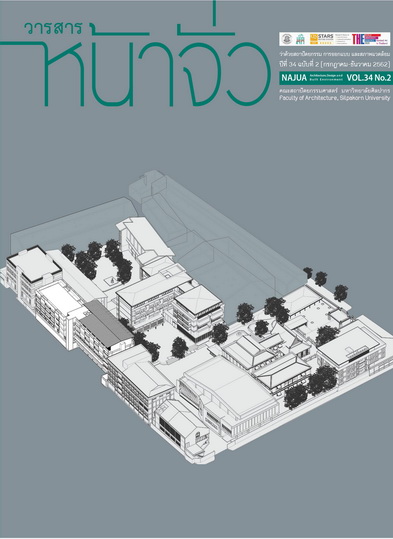ถอดบทเรียนการอนุรักษ์และพัฒนาเมืองประวัติศาสตร์เนเปิ้ลส์ อิตาลี ตามแนวทางภูมิทัศน์เมืองประวัติศาสตร์
คำสำคัญ:
เนเปิ้ลส์, การอนุรักษ์และพัฒนาเมืองเก่า, ภูมิทัศน์เมืองประวัติศาสตร์บทคัดย่อ
อิสรชัย บูรณะอรรจน์
วิทยาลัยสถาปัตยกรรมศาสตร์ มหาวิทยาลัยราชภัฏสวนสุนันทา
เกรียงไกร เกิดศิริ
คณะสถาปัตยกรรมศาสตร์ มหาวิทยาลัยศิลปากร
ปัทม์ วงค์ประดิษฐ์
สถาปนิกอนุรักษ์ และนักศึกษาทุนปริญญาเอกกาญจนาภิเษก สกว. สาขาวิชาสถาปัตยกรรมพื้นถิ่น มหาวิทยาลัยศิลปากร
บทความนี้มุ่งศึกษาเพื่อวิเคราะห์และถอดบทเรียนแนวทางการบริหารจัดการ ด้านการอนุรักษ์และพัฒนาเมืองประวัติศาสตร์เนเปิ้ลส์ ตามแนวทางภูมิทัศน์เมืองประวัติศาสตร์ จากการศึกษาแสดงถึงกลยุทธ์ของแผนปฏิบัติการท้องถิ่น ในการเชื่อมโยงคุณค่าของพื้นที่ศูนย์กลางประวัติศาสตร์ของเมือง ซึ่งรับผิดชอบโดยสภาเทศบาลนครเนเปิ้ลส์ร่วมกับบริบทแวดล้อมทางธรรมชาติของพื้นที่อ่าวเนเปิ้ลส์ ซึ่งกำกับดูแลโดยการท่าเรือเมืองเนเปิ้ลส์ รวมถึงกลไกในการประสานความร่วมมือกับเครือข่ายการแลกเปลี่ยนเรียนรู้เพื่อส่งเสริมการพัฒนาเมืองอย่างยั่งยืนของทวีปยุโรป และหน่วยงานต่าง ๆ เพื่อให้การสนับสนุนทางวิชาการและการวางแผนเชิงกลยุทธ์ต่าง ๆ ในการอนุรักษ์และพัฒนาเมืองเก่าเนเปิ้ลส์ตามกรอบแนวทางภูมิทัศน์เมืองประวัติศาสตร์
ทั้งนี้ สามารถจำแนกรูปแบบและกลไกในการขับเคลื่อนโครงการได้ 3 ลักษณะ คือ 1) โครงการที่ดำเนินการโดยหน่วยงานท้องถิ่นเป็นหลัก 2) โครงการที่ดำเนินการภายใต้เครือข่ายความร่วมมือระดับนานาชาติ 3) โครงการที่ดำเนินการโดยความร่วมมือระหว่างภาครัฐและภาคเอกชน ซึ่งทั้งหมดจะทำงานควบคู่กันเพื่อให้การขับเคลื่อนเกิดผลสัมฤทธิ์อย่างเป็นรูปธรรม
เอกสารอ้างอิง
บรรณานุกรม
- Comune Di Napoli. (2006). Il progetto sirena. Naples: Sirena ottastorica.
- Comune Di Napoli. (2010). Multi-functional Historic Urban Areas Balancing Demands and Functions. Naples: Heritage as opportunities.
- Comune Di Napoli. (2011). Local Action Plan City of Naples. Naples: Heritage as opportunities.
- GO-HUL. (2016). The HUL Guide Book: Managing heritage in dynamic and constantly changing urban environments. UNESCO (WHITRAP).
- Kirdsiri, K.. (2016) “Botkhwampae Khonaenam Kiawkap Phumitat Mueang prawattisat, (in Thai) [The Recommendation on the Historic Urban Landscape]” in Najua: Architecture, Design and Built Environment. 30(January-December 2016). D31-D32.
- Rosa, F.D. and Palma, M.D., (2013). “Historic Urban Landscape Approach and Port Cities Regeneration: Naples between Identity and Outlook” in Sustainability. 5. p.4274.
- UNESCO. (2001). Recommendation on the Historic Urban Landscape. Paris: UNESCO. 2011. Retrieved January 20, 2006, from http://whc.unesco.org/en/activities/638/
- UNESCO. (2013). New life for historic cities: the historic urban landscape approach explained. Paris: UNESCO. p.5.
Website





